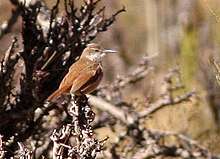Straight-billed earthcreeper
The straight-billed earthcreeper (Ochetorhynchus ruficaudus) is a species of bird in the family Furnariidae. It is found in Argentina, Bolivia, Chile, and Peru. Its natural habitat is subtropical or tropical high-altitude shrubland.
| Straight-billed earthcreeper | |
|---|---|
 | |
| Scientific classification | |
| Kingdom: | Animalia |
| Phylum: | Chordata |
| Class: | Aves |
| Order: | Passeriformes |
| Family: | Furnariidae |
| Genus: | Ochetorhynchus |
| Species: | O. ruficaudus |
| Binomial name | |
| Ochetorhynchus ruficaudus Meyen, 1834 | |
| Synonyms | |
|
Upucerthia ruficaudus (Meyen, 1834) | |
Description
The straight-billed earthcreeper grows to a length of about 18.5 cm (7.3 in). The upper parts are pale brown with rufous colour on some of the flight feathers. The tail is rufous brown, with blackish inner webs to the central feathers, and is often kept cocked at a marked angle. The throat and chest are white and the breast and belly are pale brown, with white streaks. The beak is long and straight, and there is a narrow white supercilium above the eye.[2]
Distribution and habitat
This species occurs in the foothills of the Andes Mountains, its range extending from southern Peru and the La Paz Department in western Bolivia to northern Argentina and the eastern fringes of Chile. Its typical habitats are rocky hillsides, rocky outcrops and ravines at altitudes between 1,300 and 4,300 m (4,300 and 14,100 ft), but it is more frequently occurs above 2,300 m (7,500 ft).[1][2]
Ecology
The straight-billed earthcreeper usually occurs in pairs or singly but is rather elusive, hopping about on the ground among boulders and in rocky areas. The song, often uttered from the ground, is a loud series of notes that first rises in pitch and then slowly descends and fades away.[2]
Status
The straight-billed earthcreeper has a very wide range in Bolivia, southern Peru, northern and central Chile and northwestern Argentina. It is a fairly common bird and despite the fact that the population appears to be declining, this is not happening at such a fast rate as to make it vulnerable, and the International Union for Conservation of Nature has assessed its conservation status as being of least concern.[1]
References
- BirdLife International (2012). "Ochetorhynchus ruficaudus". IUCN Red List of Threatened Species. 2012. Retrieved 26 November 2013.CS1 maint: ref=harv (link)
- Ridgely, Robert S.; Tudor, Guy (2009). Field Guide to the Songbirds of South America: The Passerines. University of Texas Press. p. 68–69. ISBN 978-0-292-71748-0.
- SACC (2007). Reinstate Ochetorhynchus and merge Chilia and Eremobius into it. Accessed 2008-10-28.
